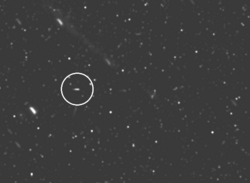Tarqeq facts for kids

Tarqeq imaged by the Cassini spacecraft in June 2016
|
|
| Discovery | |
|---|---|
| Discovered by | Scott S. Sheppard David C. Jewitt Jan Kleyna Brian G. Marsden |
| Discovery date | 13 April 2007 |
| Designations | |
| MPC designation | Saturn LII |
| Pronunciation | /ˈtɑːrkɛk/ |
|
Named after
|
Tarqiup Inua |
| S/2007 S 1 | |
| Adjectives | Tarqiupian, Tarqeqian |
| Orbital characteristics | |
| Epoch 2007 Apr. 10.0 | |
| 17.9106 Gm | |
| Eccentricity | 0.1081 |
| 894.86 d | |
| Inclination | 49.90° |
| Satellite of | Saturn |
| Physical characteristics | |
|
Mean diameter
|
6+50% −30% km |
| 76.13±0.01 h | |
Tarqeq is a small moon that orbits the planet Saturn. It is also called Saturn LII. Scientists found it in 2007. This moon is named after Tarqeq, an Inuit god of the Moon. Tarqeq is about 7 kilometers (4.3 miles) wide. The Cassini spacecraft even took a look at Tarqeq in 2014!
Contents
Discovering Tarqeq
Tarqeq was found by a team of scientists. These scientists were Scott S. Sheppard, David C. Jewitt, Jan Kleyna, and Brian G. Marsden. They announced their discovery on April 13, 2007. They used observations taken between January 2006 and March 2007.
Tarqeq's Journey Around Saturn
Tarqeq travels around Saturn in a path called an orbit.
- Its orbit is tilted by about 49.90 degrees compared to the ecliptic. The ecliptic is the path the Sun seems to take across the sky.
- The orbit is also a bit oval-shaped, not a perfect circle. Scientists call this its eccentricity.
- Tarqeq orbits Saturn in the same direction that Saturn spins. This is called a prograde orbit.
- It takes Tarqeq about 895 days to complete one trip around Saturn. That's more than two Earth years!
How Tarqeq Spins
Tarqeq spins very slowly. It takes about 76 hours (more than three days) to complete one full spin. This makes it the slowest-spinning irregular moon that the Cassini spacecraft has measured. Tarqeq also has a shape that is a bit like an oval.
Scientists think Tarqeq's slow spin might be connected to Titan. Titan is Saturn's largest moon. Tarqeq's spin period is very close to a special pattern with Titan's orbit. This pattern is called a mean-motion resonance. It means the gravity from Titan might be affecting how Tarqeq spins.
Tarqeq's Family in Space
Tarqeq is part of a group of Saturn's moons called the Inuit group. These moons are thought to have come from a larger object that broke apart. Tarqeq has a very similar orbit to another moon named Siarnaq. This suggests that Tarqeq might be a piece that broke off from Siarnaq a long time ago.
See also
 In Spanish: Tarqeq (satélite) para niños
In Spanish: Tarqeq (satélite) para niños

